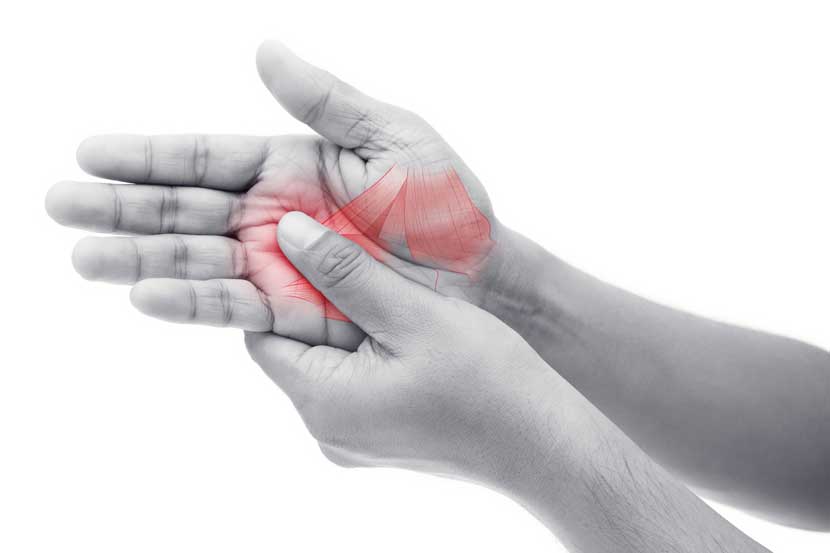Hand and Finger Fractures

What are Hand and Finger Fractures?
Hand fracture or finger fracture can make life difficult. Without much thought, we use our hands daily for working, personal hygiene, writing, household activities as well as many other tasks. Hand gestures also assist in our communication with others.
Hand and finger fractures are usually associated with a loss of function, swelling, pain and the potential for longterm disability. Motor vehicle crashes, sports related incidents, and work accidents are some of the more common causes of hand and finger fractures. Patients with these types of fractures are usually referred to an orthopedist.
The Anatomy of the Hand
The palm of the hand consists of five metacarpal bones just distal to those associated with the wrist. The finger bones are called phalanges. Two phalanges form the thumb, but there are three in all other fingers.
Ligaments connect the metacarpals and phalanges to form the interphalangeal joints. Forearm muscles have tendons that extend into the hand, and attach to the bones. These muscles, along with those within the palm, give the hand its ability to perform many complex movements.
Common Types of Hand Injuries
Hand injuries are commonly caused in car accidents, work accidents or sports related incidents. The forces associated with these events can result in fractures or crush type injuries to the metacarpals or phalanges. Nearby muscles and tendons can also be torn, and finger joints may become dislocated as a result of these types of traumas.
Other common types of hand injuries include, lacerations, finger amputations, vibratory nerve damage, as well as severed nerves and blood vessels, damaged by bone fragments.
Diagnosis
Classic signs of hand fracture include immediate pain, swelling, and reduced mobility. Bruising develops as the swelling increases. A type of hand fracture known as a compound fracture, is severe enough for bone to pierce through the skin.
After an initial exam, the next step in the assessment is imaging. X-rays reveal most fractures and dislocations. For more complicated cases, however, a CT scan or Magnetic Resonance Imaging or MRI can be helpful to better visualize fractures along with damage to muscles, tendons, and ligaments.
Treatment Options
Management is dependent on the severity of the fracture. Single finger injuries typically heal well with a closed reduction and immobilization, but more complicated fractures often require surgery.
Closed Reduction
For all fractures, the displaced bone fragments must be re-aligned to enable proper healing. A closed reduction procedure may be sufficient for uncomplicated fractures. This procedure is performed in either an emergency room or an office surgical suite. Intravenous sedation and pain medication is administered along with a local anesthetic at the fracture site.
When the area is sufficiently numb, the surgeon applies traction on each fractured bone segment, then manipulates them back into proper alignment. A splint or brace is applied to maintain this reduction, and to allow the swelling to resolve. After one to two weeks, the splint may be replaced with a forearm to finger cast for the remaining weeks of healing. Alternatively, a simple finger, or phalanges fracture, may only require a finger splint. In this situation, the fracture is immobilized, but the rest of the hand remains mobile.
Open Reduction Internal Fixation (ORIF)
When a closed reduction is unsuccessful or multiple fractures are present, a surgical reduction may be the best option. This procedure is performed in either a hospital or outpatient surgical center that has both anesthesia and radiologic capability. Fluoroscopy, a real-time x-ray, is used to help visualize the bones during the open reduction procedure.
This procedure requires general anesthesia, so someone should accompany the patient on the day of surgery. Blood thinners and non-steroidal anti-inflammatory medication can increase the risk of bleeding, so the doctor may recommend a change in a patient’s dose.
After general anesthesia has been administered, a local anesthetic is injected at the site of the fractured bone. The surgeon visualizes the pieces of bone, then re-aligns them into proper position. This alignment is confirmed via fluoroscopy, a type of x-ray imaging. Pins may then be inserted into the bone for stabilization. Metal plates may also be necessary for larger metacarpal fractures.
Once the hardware is in place, injured tendons, nerves, and blood vessels are repaired. This hardware remains within the bone permanently unless a complication develops. More recent use of bio-absorbable plates for large metacarpal fractures reduces the likelihood of such complications.
After surgery, the hand is further stabilized in a fiberglass splint. This is replaced by a new splint or cast after two weeks which is worn for four additional weeks. Pain medication will be prescribed during the initial post-operative weeks, and progress is monitored with periodic x-rays.
Recovery
Immobilization of the hand and fingers often results in stiffness and reduced mobility. Therapy is, therefore, an essential part of rehabilitation. Occupational therapy helps to improve fine finger movements that are necessary for tasks such as writing, using scissors, and fastening buttons. Physical therapy promotes hand and forearm muscle strength. A referral to a more specialized hand therapist can assist with regaining function of the hand, arm and shoulder.
The prognosis after hand fracture reduction is dependent on the severity of the injury and the amount of rehabilitation. Despite the best treatment plans, complications may occur. Arthritis can develop in previously dislocated finger joints. Muscle contractors and stiffness may cause persistent finger flexion.
In such cases, additional surgery may be necessary to remove impeding hardware or scar tissue, and to release to contracture. Because every case is unique, any treatment plan must be customized by the hand surgeon and therapists.

